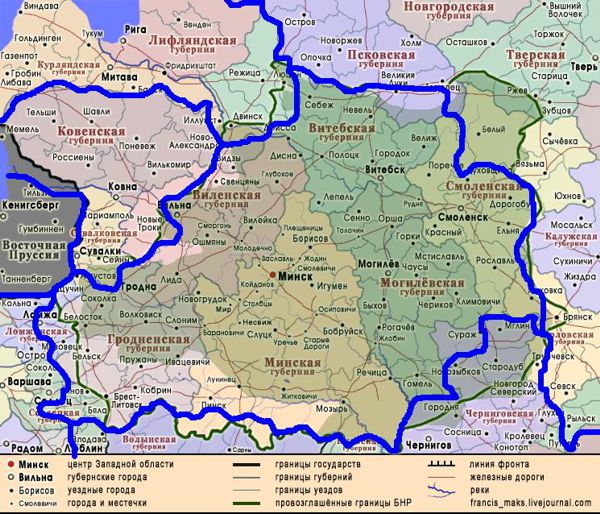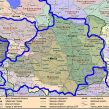
Belarusians Bristle at Russian Land Claims on Belarus
Publication: Eurasia Daily Monitor Volume: 12 Issue: 79
By:

Russian imperialists have insisted that more than any other place within the former Soviet space, Belarus is artificial. They reach this conclusion on the basis that Belarus is culturally related to Russia on many measures, had only a brief experience with national independence before 1991, and—what they see as their trump card—underwent frequent border changes by others, including Moscow. As a result, these Muscovites suggest, Belarusians should not be adverse to the inclusion of what is now an independent state within the borders of the Russian Federation.
Belarusian nationalists have responded by highlighting the distinctiveness of their national language and culture and pointing to Belarusian participation in the Polish-Lithuanian Commonwealth, the largest state in the region in early modern times and, at one point, the conquerer of Moscow. And now they have responded to the third element of the Russian imperialist argument by pointing out that, all the border changes notwithstanding, the current map of Belarus reflects the continuity of nation’s core territory, which does not contain any territories that were Russian from time immemorial.
In an interview with the independent SNPlus Belarusian news service, Leonid Spatkaya, a former border guard who has spent decades studying these issues, describes the history of the borders of his country, detailing their changes over the last century (Sn-plus.com, April 23; Belaruspartisan.org, April 25).
In March 1918, the Belarusian People’s Republic asserted that the territory of that state should include “all lands where Belarusians live and have a majority.” Officials of this fledgling state drew on the work of Tsarist-era scholars including E. F. Karsky, who wrote “On the Question of the Ethnographic Map of the Belarusian Tribe,” published in 1902. The map generated from that definition of the borders was produced in a brochure by M. V. Dovnar-Zapolsky entitled “The Basis of the Statehood of Belarus” and presented at the Paris peace conference.
Not surprisingly, all of Belarus’ neighbors challenged that map, arguing that borders must be defined not only in terms of the nationality of the majority in existing political subdivisions, which had favored Belarus, but also in terms of other divisions based on the economic and political arrangements that they had created. These arguments were trumped in many cases by the course of military actions and revolutionary change—borders of Central and Eastern Europe were fluid and often changed between 1918 and 1920. In the end, many ethnographically Belarusian lands were absorbed by neighboring countries, and few non-Belarusian groups were locally predominant in Belarus itself. In his interview, Spatkaya discusses these moves back and forth in extreme detail, pointing out that Poland, Lithuania, Russia and Ukraine all benefitted at Belarus’ expense.
Belarusian officials pressed for the return of these lands and, in the course of the 1920s, had some success everywhere except relative to the Russian Soviet Federative Socialist Republic (RSFSR), Spatkaya says. Belarusians expected that all Belarusian lands, including “almost all of Smolensk oblast and the greater part of Bryansk oblast” would be returned to them. “But after the beginning of the first wave of terror,” the national elites were unwilling to raise the issue.
The next big change in Belarusian borders came in September 1939, when Moscow added to Belarus territories it had seized from Poland. As a result, the area of Belarus grew to 225,600 square kilometers and its population to 10.239 million. But even in this case, Spatkaya argues, Belarus did not receive all the territory it should have. Instead, Moscow decided in favor of Lithuania and Ukraine in the case of several disputed areas.
After these gains, the expert says, Belarus began to lose territory. At the end of World War II, Moscow added some historically Belarusian lands to Belarus at the expense of Poland while taking other Belarusian lands and including them within the RSFSR as part of the general redrawing of borders in Eastern Europe. “As a result” of this way in which Belarusian territories were historically used as “currency” in dealings with other countries, present-day Belarusian leader Alyaksandr Lukashenka is quite within his rights to talk about transferring Kaliningrad oblast to Belarus, Spatkaya says.
But even after these border redrawings were finished, Moscow’s “cutting down” of Belarus did not end. At the request of Warsaw, the Soviet Union handed over historically Belarusian lands to Poland several times between 1946 and 1955. Then, in 1961 and 1964, at the demand of Belarusians in Smolensk, Moscow transferred small portions of land there to Belarus, putting in place the borders that Belarus obtained when it became independent in 1991.
Spatkaya’s recounting of all these border changes is certain to be used by Belarusians to oppose Russian claims for more Belarusian land. And the resentment that historical border changes have already generated is likely to grow every time someone in Moscow suggests that there is no such thing as a Belarusian state or a Belarusian border. History says otherwise, and Belarusians clearly are increasingly conscious of that fact.




